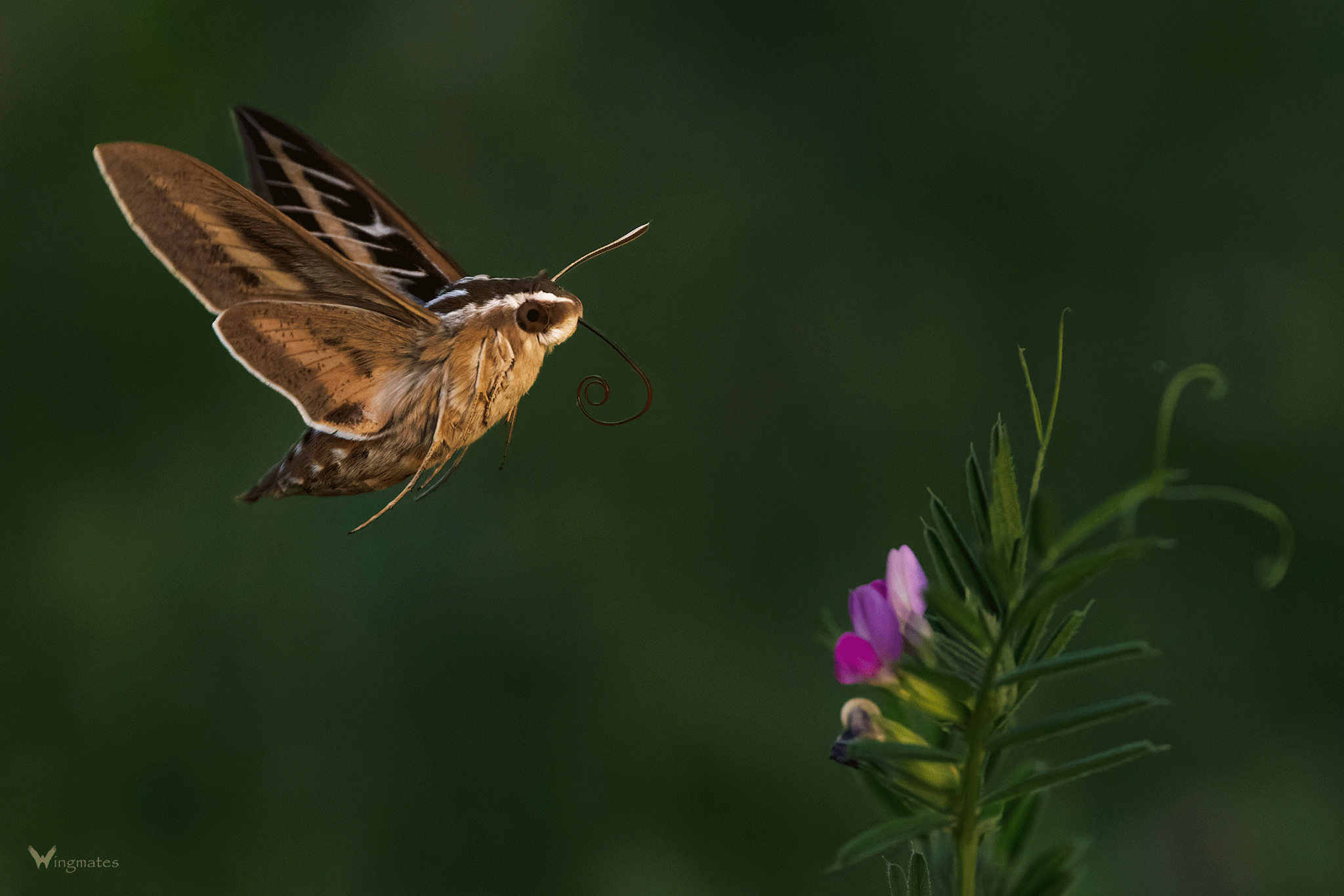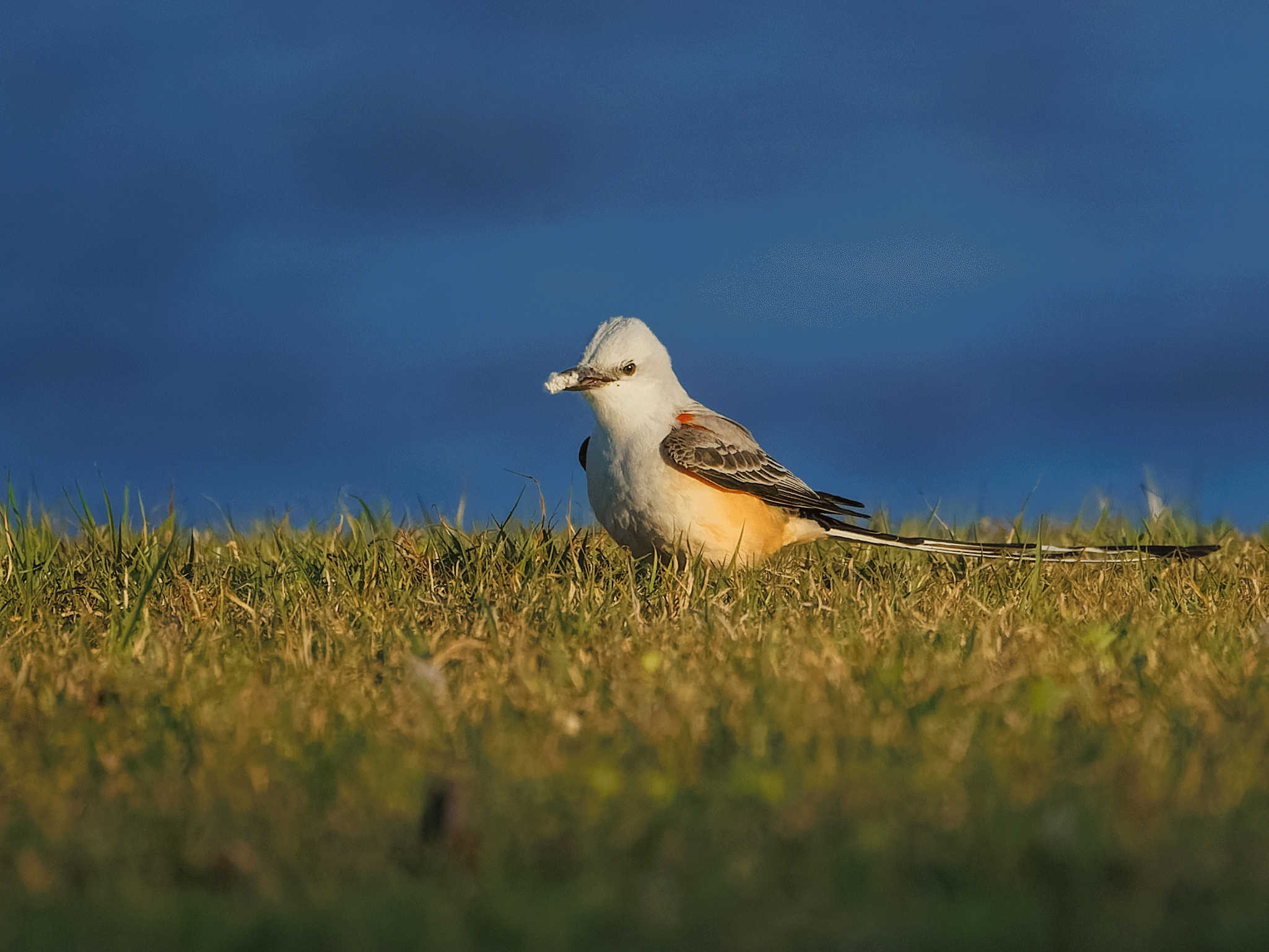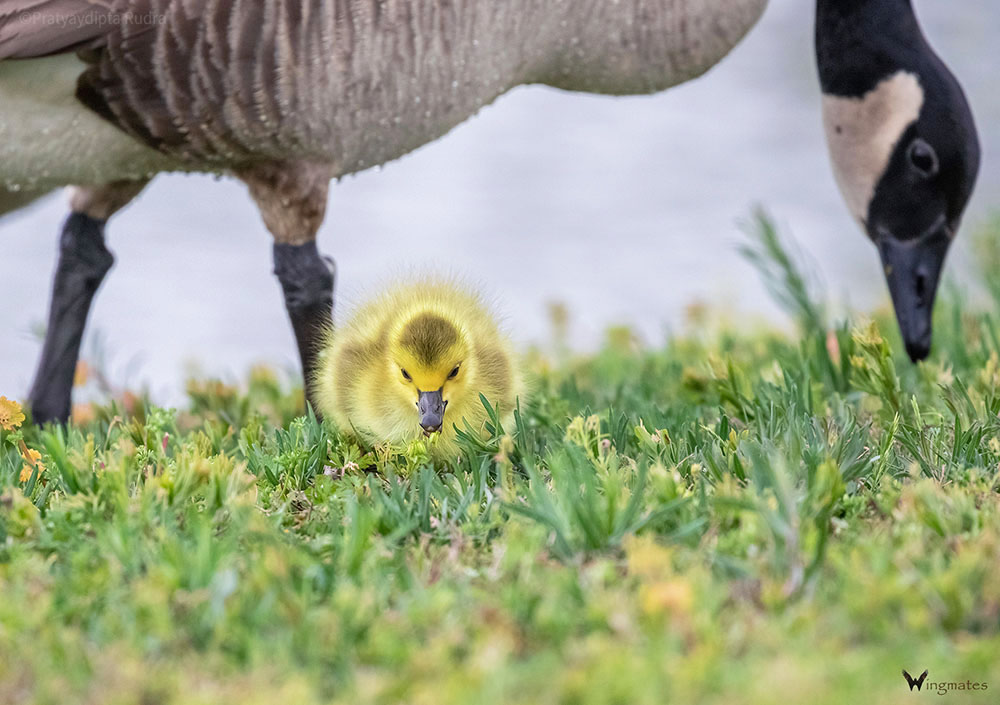
The month of April was quite happening for the Wingmates. It is the time when spring migration starts to pick up, and we were very happy to see a lot of bird activity.
Early April is usually a good time to look for sparrows since some of the wintering sparrows can still be seen while migrating and breeding sparrows also start arriving. We went out for a walk at OSU Botanical Garden and Teal Ridge Wetlands. We saw as many as nine sparrow species. You will see photos of seven of them below. We also saw House Sparrows, but they are not only a non-native and invasive species, they are also unrelated to the North American sparrows. So, we didn’t include them to our “sparrow list”. The White-crowned and Harris’s Sparrows were almost ready to leave for their summer breeding ground.
 Harris’s Sparrow showing off its breeding plumage
Harris’s Sparrow showing off its breeding plumage
 White-crowned Sparrow
White-crowned Sparrow
 Lincoln’s Sparrow in a thorny habitat.
Lincoln’s Sparrow in a thorny habitat.
 Savannah Sparrow
Savannah Sparrow
 Chipping Sparrow posing with fresh green plumage.
Chipping Sparrow posing with fresh green plumage.
 Clay-colored Sparrow. This was a good year for them.
Clay-colored Sparrow. This was a good year for them.
 Swamp Sparrow
Swamp Sparrow
This is the only time of the year when we see Harris’s Sparrows in their breeding plumage. But I love them in their winter plumage too.
 Harris’s Sparrow filling up before its migration to the breeding grounds.
Harris’s Sparrow filling up before its migration to the breeding grounds.
Amongst all the fun things that spring brings in, there is only one thing that we aren’t excited about. The grasses were out of their dormancy and so were our days for mowing which we both hate. We used the tiny little wildflowers popping up everywhere on the lawn as the excuse to not mow. More and more wildflowers started to pop as the month progressed. The time for the field pansies was up. It was time for the false garlics and wood sorrels, and of course, the pink evening primroses. Last year, we had a patch of our lawn fully covered by beautiful blooms of the primroses which lead us to not mow that part of the lawn for almost two months. This year was not as rainy and therefore not as good for them, but it was still quite a show. Pratyay simply loves these flowers!
 Venus’s Looking Glass
Venus’s Looking Glass
 Pink Evening Primrose
Pink Evening Primrose
 Yellow Wood Sorrel
Yellow Wood Sorrel
 Violet Wood Sorrel
Violet Wood Sorrel
Yellow Wood Sorrels remind Pratyay of childhood when he and his friends used to eat the leaves, slightly sour in taste, just for fun! Wild garlics can also be eaten, but you must be careful while eating parts of wild plants. Many plants look quite similar and eating parts of the wrong plant by mistake can be very costly, even fatal. For instance, the flowers in the following image are from a plant commonly known as False Garlic or Crow Poison (Nothoscordum bivalve). They look quite similar to wild garlic plants, hence the first name. But the second name makes you skeptic about eating this plant, right? Rightly so. It is documented to be poisonous by some references. A very similar looking plant known as Star of Bethlehem (Ornithogalum umbellatum) can also be toxic to humans and pets. A plant with somewhat similar looking flowers, Nuttal’s Death Camas (Zigadenus nuttallii) is highly toxic and can potentially kill you! So, be careful!
 False Garlic
False Garlic
We found some nice-looking larvae in the Pink Evening Primrose, and was wondering what they were. Thanks to a friend (Alex Harman), they were identified as the larvae of White-lined Sphinx moth. These hawk moths are beautiful and Pratyay was happy to know that they were around.
 Pink Evening Primrose and White-lined Sphinx larva
Pink Evening Primrose and White-lined Sphinx larva
 Adult White-lined Sphinx on Pink Evening Primrose
Adult White-lined Sphinx on Pink Evening Primrose
Then came a special day! We observed a couple of White-lined Sphinx moths on the wild pea around sunset and started taking some photos. As the sun started going down, their numbers kept increasing. At one point, we were seeing a couple dozens of them vigorously feeding on the wildflowers. These moths hover over the flowers like hummingbirds while feeding. This may seem like an easy photo op, but it requires a very high shutter speed to freeze their wings in motion and a high frame rate to consistently get good wing positions. Pratyay kept trying until he got some images that he liked. Spending the golden hour with these beauties was the best thing he could hope for. Did we tell you that these moths are Pratyay’s favorite?
 White-lined Sphinx feeding during golden hour
White-lined Sphinx feeding during golden hour
 The wings are beautiful!
The wings are beautiful!
 The last rays of sun on the White-lined Sphinx
The last rays of sun on the White-lined Sphinx
We thought you would enjoy looking at these beauties in motion! So, here’s a gif made out of a series of images captured in burst.
 White-lined Sphinx feeding on wild pea
White-lined Sphinx feeding on wild pea
We are still learning our butterflies. Unknowingly we captured a rare butterfly, a Fulvia Checkerspot, in our backyard which was apparently was never recorded in our county before!
 Fulvia Checkerspot
Fulvia Checkerspot
As spring migration was on its way, our backyard was exceptionally busy with migrants and common breeders which we were missing for a while! Yellow-rumped Warblers jumped from one branch to another while feeding on the little insects on the new leaves of our cottonwood tree. Pine Siskins also appeared, but they preferred the pecan tree for their morning snacking. American Goldfinches mobbed our feeders and ate just as crazy like us. We also saw Baltimore Orioles, Yellow Warblers, Carolina Chickadees, Carolina Wrens (singing!), Cardinals, Blue Jays, Brown Thrashers etc. The Great-crested Flycatchers were back and calling loudly.
 Yellow-rumped Warbler on cottonwood.
Yellow-rumped Warbler on cottonwood.
 Carolina Wren
Carolina Wren
 Blue Jay
Blue Jay
 Baltimore Oriole sitting pretty on our pecan tree.
Baltimore Oriole sitting pretty on our pecan tree.
A nice little surprise was this Bell’s Vireo, a first-time visitor to our backyard. Below are some more images of the common backyard birds.
 Bell’s Vireo
Bell’s Vireo
 Gray Catbird breeding display
Gray Catbird breeding display
 Eastern Kingbird
Eastern Kingbird
 Northern Mockingbird
Northern Mockingbird
 Downy Woodpecker
Downy Woodpecker
 Pine Siskin, looking for some protein in the buds.
Pine Siskin, looking for some protein in the buds.
 American Goldfinch takes off. This bird was transitioning into brighter breeding plumage.
American Goldfinch takes off. This bird was transitioning into brighter breeding plumage.
 Bright little American Goldfinch grabbing a dried pecan.
Bright little American Goldfinch grabbing a dried pecan.
 Male Eastern Bluebird with beetle catch sitting in the rain.
Male Eastern Bluebird with beetle catch sitting in the rain.
 Another backyard Goldfinch. We had a decent amount of rain in early spring.
Another backyard Goldfinch. We had a decent amount of rain in early spring.
 Female Eastern Bluebird
Female Eastern Bluebird
Spring also brings in the Turkey Vultures to this part of the world. Not everyone’s favorite, but it feels great to see the large birds soaring above. Hope we don’t have to emphasize their importance for the ecosystem.
 Turkey Vultures have returned…
Turkey Vultures have returned…
We were out to our favorite spring birding place, a nearby lake, looking for the arrival of the Scissor-tailed Flycatchers. We didn’t have to look for too long! A scissortail flying off from this bald cypress, and we knew that these flycatchers were indeed back to their breeding grounds. We could not be happier. Many of them were observed soon. Feeding, fighting for the territory, and some chasing that seemed to be more like a romantic endeavor!
 Out at the lake, Sreemala looking for Scissor-tailed Flycatchers.
Out at the lake, Sreemala looking for Scissor-tailed Flycatchers.
 First scissortail of the year! Taking off from a bald cypress right next to the lake.
First scissortail of the year! Taking off from a bald cypress right next to the lake.
 Mr Scissortail sitting while Mrs tries to grab some food.
Mr Scissortail sitting while Mrs tries to grab some food.
 Scissortails chasing each other.
Scissortails chasing each other.
 Mated pair of Scissor-tailed Flycatchers take a sunset flight together.
Mated pair of Scissor-tailed Flycatchers take a sunset flight together.
At sunset we saw the scissortails feasting on the large flocks of mosquitoes while getting ready for their breeding season. Seemed like they had so much food available that they could raise an army of little ones!
 This year we wanted to capture some flight photos with more interesting background instead of the plain blue sky. We got a few photos like this that we liked.
This year we wanted to capture some flight photos with more interesting background instead of the plain blue sky. We got a few photos like this that we liked.
 Scissortail in front of the lake.
Scissortail in front of the lake.
 Grabbing some mosquitoes on the go. No shortage of food at all!
Grabbing some mosquitoes on the go. No shortage of food at all!
 Getting a nice juicy meal…
Getting a nice juicy meal…
However, not all days were as good for the mosquitoes. Especially early in the spring, when it is colder, it can be hard to find flying insects. The scissortails seemed to have a plan B though. They explored the grassy fields to find some larvae (perhaps some kind of beetle larvae) from the grass. It was amazing to see how much one bird could eat during a small amount of time. We lied on the grass for half an hour at this location and observed these birds flying around and eating the larvae.
 Scissortail looking for beetle larvae
Scissortail looking for beetle larvae
 Tasty!
Tasty!
 There’s one more!
There’s one more!
 Got it!
Got it!
 Yummy!
Yummy!
 Taking off after finishing the meal.
Taking off after finishing the meal.
 In case you did not know how to gulp down a bug!
In case you did not know how to gulp down a bug!
Can’t get enough of our state bird! They are simply majestic.
 Looking for the next meal.
Looking for the next meal.
Pratyay keeps saying that adding a Scissortail to any scene can make it special. Below is a sunset silhouette with birds (scissortails, a mockingbird, and a flock of blackbirds) flying around. Do you see the scissortails?
 Sunset hues and some winged critters.
Sunset hues and some winged critters.
 A beautiful sunset at the lake. The birds against the sun are Franklin’s Gulls.
A beautiful sunset at the lake. The birds against the sun are Franklin’s Gulls.
At the end of the third week of April, we took part in a big birding day here in Oklahoma and visited a few of our favorite places. We already wrote a blog post about it. Here is the link to it if you have not read about that adventure yet.
April is baby time for many birds. Sreemala captured a Northern Cardinal in its “angry bird” self bringing in some insects for the newborns, while Pratyay was happy to spend some time with a Canada Goose family with some fluffballs, aka goslings.
 The angry bird (Northern Cardinal)
The angry bird (Northern Cardinal)
 Canada Goose keeping an eye on a little gosling.
Canada Goose keeping an eye on a little gosling.
But the best part of the baby season was the Eastern Bluebirds! We had installed a birdhouse last spring, but had to take it down because the House Sparrows drove everyone else away while trying to claim the box. We decided to put it up again this spring hoping that the Bluebirds will call it home this time. We were so happy to see a Bluebird pair checking out our birdhouse and coming in with nesting materials! The House Sparrows were nowhere to be seen… a relief!
The same Bluebird pair seemed to have four young ones from earlier this season. They were apparently trying to breed for the second time, which is fairly common. The young bluebirds from the previous brood were still begging for food, and they were very surprised why the parent wouldn’t feed them anymore. :(
 Female Eastern Bluebird
Female Eastern Bluebird
 Baby Bluebird on our pecan tree.
Baby Bluebird on our pecan tree.
 Baby blue not sure why daddy came back without food. Daddy seemed to be quite indifferent.
Baby blue not sure why daddy came back without food. Daddy seemed to be quite indifferent.
 Female Bluebird bringing nesting materials.
Female Bluebird bringing nesting materials.
 Leaving after working on the nest.
Leaving after working on the nest.
Towards the end of the month, we became confused as the bluebirds stopped bringing in nesting materials and they didn’t seem to be incubating eggs either. Did they decide not to nest here? We would soon find it out. But it was time for us to leave for a long trip to the East. Guess we have to wait for three weeks to find out what happened with the bluebird nest.